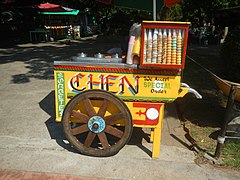Sorbetes
It has been suggested that Mango ice cream be merged into this article. (Discuss) Proposed since July 2021. |
  Top: Cheese (queso) and chocolate sorbetes Bottom: Traditional sorbetero pushcart | |
| Type | Ice cream |
|---|---|
| Place of origin | Philippines |
| Serving temperature | Cold |
Sorbetes is a traditional ice cream originating from the Philippines and uniquely characterized by the use of coconut milk and/or carabao milk.[1][2] Often pejoratively called "dirty ice cream",[3][4] it is distinct from the similarly named sorbet. It is traditionally peddled in colorful wooden pushcarts by street vendors called "sorbeteros". It is served in various flavors (usually dyed in bright colors) in small wafer or sugar cones and more recently, as a pandesal bread ice cream sandwich.
History and formulation[]
Ice cream was introduced in the Philippines during the American Occupation when refrigerators and other cooling devices were introduced.[5] While American ice cream was made with cow's milk, using the milk of the carabao resulted in a cheaper product which became known as "sorbetes". Both kinds of milk are widely used today. Coconut milk and cassava flour are two other ingredients used that make sorbetes distinct from ice cream made in other countries.[6] Flavors also varied from the usual natural fruits and plants such as mango, ube, avocado, melon, jackfruit, coconut and strawberry to flavors imitating commercial ice cream such as chocolate, cookies and cream, cheese, mocha, etc.[citation needed]
The sorbetes industry competes with commercially available ice cream from giant companies operating in the Philippines such as Arce Dairy, Esmerald, Darchelle, Magnolia, Nestlé, and Selecta, which also recently started selling their products on the streets in more modern refrigerated carts.[citation needed]
Sorbetero[]
This section needs additional citations for verification. (September 2021) |

Sorbetes are peddled by sorbeteros (ice cream vendor)[7] using colorfully[4] painted wooden carts which usually can accommodate three flavors, each in a large metal canister. Peddlers get their carts from makers scattered around the cities of the Philippines in the morning and walk the streets the whole day, calling consumers from their houses by ringing a small handheld bell.[8]
The wooden cart has two large wooden wheels at the front part to easily push the cart though latest carts are already attached to bicycles.
The cart is stuffed with shaved ice sprinkled with salt to produce a lower temperature around the metal canisters and keep the sorbetes frozen longer.[9]
The whole sorbetes cart is also available for private gatherings when negotiated with the sorbetero. It is usually cheaper than buying gallons of ice cream to be served to guests.
Sorbeteros provide several serving options. It may be served in a wafer cone, a sugar cone or a bread bun, at varying prices. A serving can include one flavor or, for no extra charge, a mixture of available flavors.
The Sorbetero has also been depicted in film and in song such as the 1979 film Mamang Sorbetero and the song Mamang Sorbetero that was performed by Celeste Legaspi.[10]
Gallery[]

A woman purchasing strawberry sorbetes from a street vendor in La Trinidad, Benguet

Traditional colorful wooden sorbetes pushcart in Rizal Park, Manila

Children buying sorbetes in Baguio City

Sorbetero serving sorbetes in the Malolos Historic Town Center, Bulacan

Mango sorbetes from Barili, Cebu
See also[]
- Halo-halo
- Ice buko
- Ice scramble
- List of Philippine desserts
- Saba con hielo
- Ube ice cream
- Queso ice cream
- Mango ice cream
References[]
- ^ "Filipino Dirty Ice Cream is Central London's Hottest Treat". Embassy of the Philippines, London. Republic of the Philippines. Retrieved 17 July 2021.
- ^ "Home-Based Food Business Idea: Recipe for Sorbetes". Business News Philippines. Retrieved 17 July 2021.
- ^ "Gen Z calls out Tiktoker for captioning dirty ice cream, well, dirty ice cream". Manila Bulletin. 20 May 2021. Retrieved 20 July 2021.
- ^ a b Fausto, Angela Marie; Ocampo, Carla; Robles, Krisella; Custodio, Benette (2018). "An Ergonomic Analysis of the Traditional Sorbetes Cart". Advances in Physical Ergonomics and Human Factors. Advances in Intelligent Systems and Computing. Springer International Publishing. 602: 114–123. doi:10.1007/978-3-319-60825-9_14. ISBN 978-3-319-60824-2. Retrieved 21 July 2021.
- ^ Diana Galang. "Sorbetes And The Philippine Dessert Repertoire". Manila Bulletin via mb.com.ph.
- ^ Mishell M. Malabaguio. "How To Make Sorbetes (Home-made Ice Cream)". www.entrepreneur.com.ph.
- ^ Polistico, Edgie (15 November 2017). Philippine Food, Cooking, & Dining Dictionary. Anvil Publishing, Inc. ISBN 978-621-420-087-0. Retrieved 20 July 2021.
- ^ Sotelo, Yolanda (30 June 2012). "Not-so-'dirty' ice cream brings in clean profit". Retrieved 20 July 2021.
- ^ "Why do they use salt to melt ice on the road in the winter?".
- ^ Gabinete, Jojo (10 February 2021). "Trailer ng Tililing, sagana sa malulutong na mura, maseselang lengguwahe". PEP.ph. Retrieved 20 July 2021.
- Philippine desserts
- Ice cream
- Foods containing coconut





